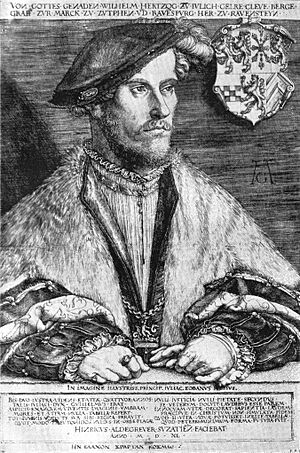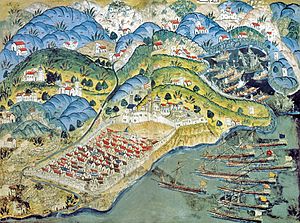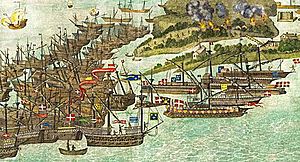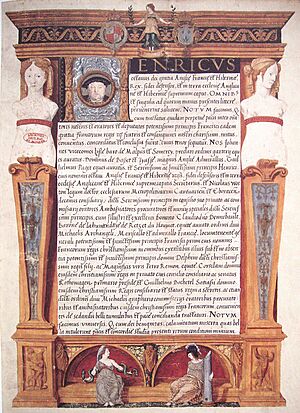Italian War of 1542–1546 facts for kids
Quick facts for kids Italian War of 1542–1546 |
|||||||
|---|---|---|---|---|---|---|---|
| Part of the Italian Wars | |||||||
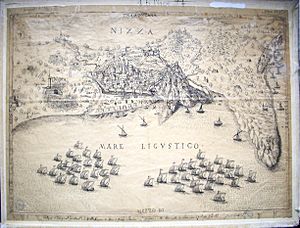 The siege of Nice by a Franco-Ottoman fleet in 1543 (drawing by Toselli, after an engraving by Aeneas Vico) |
|||||||
|
|||||||
| Belligerents | |||||||
|
|
|
||||||
| Commanders and leaders | |||||||
The Italian War of 1542–1546 was a big conflict in Europe. It was part of the longer Italian Wars. This war involved Francis I of France and Suleiman the Magnificent from the Ottoman Empire fighting against Emperor Charles V and Henry VIII of England.
Battles took place in Italy, France, and the Low Countries (modern-day Belgium, Netherlands, Luxembourg). There were also attempts to invade Spain and England. In the end, no side truly won, and the war cost a lot of money for everyone involved.
The war started because a previous peace agreement, the Truce of Nice (1538), didn't solve the main problems between Charles and Francis. They especially disagreed over who should control the Duchy of Milan. Francis declared war again in 1542.
Fighting began in the Low Countries. The next year, France and the Ottoman Empire attacked Nice. There was also a major battle in Italy called the Battle of Ceresole. Later, Charles and Henry invaded France. However, long sieges of Boulogne-sur-Mer and Saint-Dizier stopped them from making a big push into France.
Charles made peace with Francis in 1544 with the Treaty of Crépy. But this treaty didn't last long because Francis's younger son, the Duke of Orléans, died. His marriage was a key part of the treaty. Henry VIII kept fighting until 1546. He signed the Treaty of Ardres, which finally brought peace between France and England. Both Francis and Henry died in 1547, leaving their successors to deal with the ongoing Italian Wars.
Why the War Started
The Truce of Nice in 1538 was supposed to end the fighting between Emperor Charles V and King Francis I. But it didn't solve their main disagreements. Both rulers were unhappy with the outcome.
Francis still wanted the Duchy of Milan, which he believed was his by family right. Charles, on the other hand, wanted Francis to follow the rules of the Treaty of Madrid. This treaty had been forced on Francis when he was a prisoner in Spain after an earlier war. They also argued over other lands, like Burgundy (Charles's claim) and Naples and Flanders (Francis's claims).
Leaders tried to negotiate in 1538 and 1539. Charles even traveled through France, but they couldn't agree on political issues. In 1540, Charles suggested a marriage between his daughter or niece and Francis's son, the Duke of Orléans. This would give the Duke control of the Netherlands and Burgundy after Charles's death. In return, Francis would give up his claims to Milan and Savoy. Francis didn't agree, and the talks failed.
Francis then looked for new friends. William, Duke of Jülich-Cleves-Berg, who was fighting Charles over land, joined Francis. He married Francis's niece, Jeanne d'Albret. Francis also tried to get help from the Schmalkaldic League (German Protestant princes), but they made their own deals with the Emperor.
However, Francis had more success with the Franco-Ottoman alliance. Suleiman the Magnificent of the Ottoman Empire wanted to keep Charles busy in Europe. This would stop Charles from interfering with Ottoman plans in Hungary.
In 1541, a French ambassador was killed by Imperial troops. Francis was very angry, but Charles denied responsibility. Charles was planning a campaign in North Africa and wanted to avoid more trouble in Europe.
Charles's attack on Algiers failed badly due to storms. When a new French ambassador returned from Constantinople in 1542 with promises of Ottoman help, Francis declared war on July 12. He listed the ambassador's murder as a major reason.
Early Battles and the Treaty of Venlo
France immediately attacked Charles's lands from two sides. In the north, the Duke of Orléans captured Luxembourg for a short time. In the south, a larger French army tried to capture Perpignan in Spain but failed. Francis himself was busy dealing with a tax revolt in France.
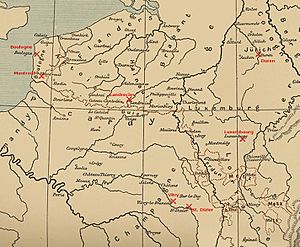
At this time, relations between Francis and Henry VIII of England were getting worse. Henry was angry because France hadn't paid him money they owed from old treaties. He was also worried about France helping Scotland, where Henry was trying to arrange a marriage for his son. This led to a conflict known as the "Rough Wooing".
Henry wanted to go to war with France in 1543. He signed a treaty with Charles V on February 11, 1543, agreeing to invade France together within two years. Henry declared war on France on June 22.
Fighting spread across northern France. English troops arrived in Calais to help defend the Low Countries. The French captured Lillers and Landrecies. Wilhelm of Cleves openly joined France and invaded Brabant.
However, Charles attacked Wilhelm of Cleves, capturing Düren. Francis ordered his troops to attack Luxembourg to help Wilhelm, and they took the city on September 10. But it was too late for Wilhelm. He had already surrendered on September 7, signing the Treaty of Venlo with Charles. This treaty forced Wilhelm to give up his claims to Duchy of Guelders and County of Zutphen to Charles. He also had to help Charles against the Protestant Reformation. Charles then moved to besiege Landrecies, but the French defenders held out. Francis later pulled his army back, allowing Charles to capture Cambrai.
In the Mediterranean Sea, other battles were happening. In April 1543, the Ottoman Sultan sent his fleet, led by Hayreddin Barbarossa, to help the French king. Barbarossa sailed along the Italian coast, raiding towns. In July, he arrived in Marseilles, where he met the French fleet commander.
On August 6, the combined French and Ottoman fleets attacked the city of Nice. They landed troops and began a siege. Nice fell on August 22, but the main fortress held out until September 8.
Barbarossa needed supplies for his fleet. Francis ordered the people of Toulon to leave their homes so Barbarossa could use the city as a base for his 30,000 soldiers for eight months. Francis became embarrassed by the Ottoman presence. In May 1544, the Ottoman fleet, with some French ships, sailed back to Istanbul, raiding the Neapolitan coast on the way.
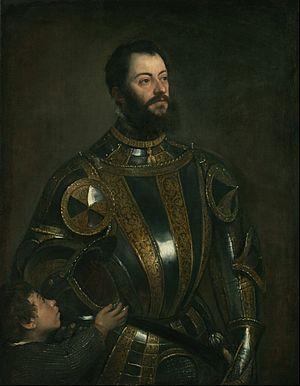
Meanwhile, in Piedmont, Italy, the French army and the Imperial army were in a stalemate. The Imperial army had captured a fortress, and the French were trying to get it back. In the winter of 1543–44, Francis sent many more troops to Italy.
On April 11, 1544, the French and Imperial armies fought a major battle at Ceresole. The French won this battle. However, Francis had to move many of his troops from Italy to defend France because Charles and Henry were planning to invade. This meant the French couldn't capture Milan. The Imperial army later won a smaller battle at Serravalle in June 1544, which ended the main fighting in Italy.
Denmark Joins the Fight
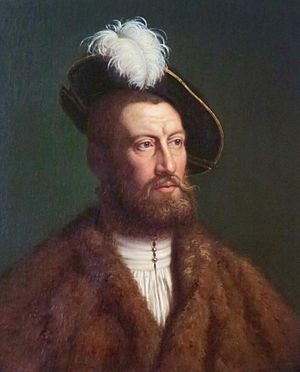
Emperor Charles V refused to accept Christian III as the true King of Denmark. This led Denmark to form an alliance with France in 1541. Denmark declared war on the Habsburg Netherlands, which was under Charles's rule.
Denmark's main action was to block shipping from the Netherlands through The Sound and the Belt. Even though a Danish fleet was near the Netherlands, there were no major land battles.
A peace treaty was signed between Denmark and the Holy Roman Empire in 1544 at Speyer. In this treaty, Charles finally recognized Christian III as the King of Denmark. In return, Dutch ships were allowed to pass freely through The Sound.
Invasion of France
On December 31, 1543, Henry VIII and Charles V signed a treaty. They promised to invade France together by June 20, 1544. Each would bring a large army. Francis I had about 70,000 soldiers ready to defend France.
The invasion was delayed because Henry had to deal with Scotland, and Charles had to deal with German princes. By May 1544, Henry felt safe from Scotland and began preparing his army. Charles also made agreements with the German princes, and some joined his invasion.
By May 1544, two Imperial armies were ready to invade France. One was in Luxembourg, and the other was in the Palatinate. Charles had over 42,000 soldiers. On May 25, the Imperial army captured Luxembourg and moved towards France. On July 8, they began to besiege Saint-Dizier.
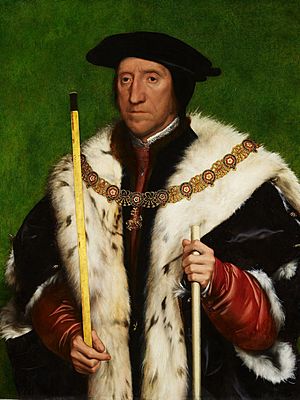
Meanwhile, Henry VIII sent about 40,000 English soldiers to Calais. This army was led by Thomas Howard, 3rd Duke of Norfolk, and Charles Brandon, 1st Duke of Suffolk. The English army was quite old-fashioned, with many soldiers using longbows instead of newer firearms.
Henry decided to split his army. Norfolk was sent to besiege Montreuil, but he struggled due to lack of supplies. Suffolk was ordered to attack Boulogne. Henry himself crossed to Calais on July 14 to join the siege of Boulogne. The siege began on July 19, even though Emperor Charles wanted Henry to march towards Paris.
Charles was still stuck at Saint-Dizier. The city's defenders held out for 41 days, which slowed down the Imperial attack. On August 17, the French defenders surrendered. Charles then moved towards Châlons, capturing several towns along the way.
The French did not try to stop Charles's army directly. Paris was in a panic, but Francis told everyone not to worry. Charles finally turned back on September 11. Henry, still at Boulogne, saw the town fall in early September. The castle surrendered a few days later.
The Treaty of Crépy
Charles V was running out of money and had religious problems in Germany. He asked Henry VIII to continue the invasion or let him make a separate peace. But before Henry could reply, Charles had already signed a treaty with Francis I.
This peace treaty, called the Peace of Crépy, was signed on September 18, 1544, in Crépy. It was supported by Charles's sister, Eleanor of Austria, and Francis's mistress.
The treaty said that Francis and Charles would give up their claims to each other's lands. Charles would give up his claim to Duchy of Burgundy, and Francis would give up his claim to Kingdom of Naples. Francis also gave up his claims to Flanders and Artois.
Francis's son, the Duke of Orléans, was to marry either Charles's daughter or his niece. Depending on who he married, he would receive either the Netherlands and Franche-Comté, or Milan. Francis also had to give some French duchies to his son. He also gave up his claims to Savoy and Piedmont. Finally, Francis agreed to help Charles fight the Ottomans. There was also a secret part of the treaty where Francis agreed to help Charles reform the church and fight against Protestantism if needed.
The treaty was not popular with Francis's older son, the Dauphin Henry, who felt his younger brother was getting more. Henry VIII also felt betrayed by Charles. The Ottoman Sultan was also unhappy. Francis did follow some parts of the treaty, but the death of the Duke of Orléans in 1545 made the main marriage plan impossible.
Fighting Continues: Boulogne and England

The war between Francis and Henry VIII continued. The French army forced the English to stop their siege of Montreuil. Henry VIII went back to England in September 1544, leaving his generals to defend Boulogne. However, they pulled most of the English army back to Calais, leaving only about 4,000 men to defend Boulogne.
The French army then focused on besieging Boulogne. On October 9, a French attack almost captured the city, but the soldiers started looting too early and were pushed back. Peace talks failed because Henry refused to give Boulogne back and wanted Francis to stop supporting the Scots.
Francis then planned a big attack on England itself. He gathered an army of over 30,000 men in Normandy and a fleet of about 400 ships at Le Havre. All of this was led by Claude d'Annebault. On May 31, 1545, a French force landed in Scotland.
In early July, the English fleet attacked the French fleet, but bad weather stopped them. The French also had bad luck: d'Annebault's first ship burned, and his second ran aground. On July 16, the large French fleet sailed into the Solent (a strait in England) and briefly fought the English fleet on July 19. The famous English ship, the Mary Rose, sank accidentally during this skirmish.
The French landed on the Isle of Wight on July 21 and again at Seaford on July 25. But these landings didn't achieve much. The French fleet soon returned to blockading Boulogne. D'Annebault made one last attack near Beachy Head on August 15 but then went back to port.
The Treaty of Ardres
By September 1545, the war was stuck. Both sides were running low on money and soldiers. They tried to get help from German Protestants but failed. Henry, Francis, and Charles tried to negotiate, but they didn't trust each other.
In January 1546, Henry sent troops to Calais, making it look like he was preparing for another attack, but nothing happened. Francis couldn't afford a big war, and Henry only cared about Boulogne.
Negotiations started again on May 6. On June 7, 1546, the Treaty of Ardres (also called the Treaty of Camp) was signed. This treaty stated that Henry would keep Boulogne until 1554. Then, he would return it to France in exchange for two million écus (French money). In the meantime, neither side would build new forts in the area, and Francis would start paying Henry's pensions again.
The treaty also included Scotland. Henry promised not to attack the Scots again without a good reason. This gave Scotland a break from the "Rough Wooing" war, but fighting would start again 18 months later.
What Happened After the War
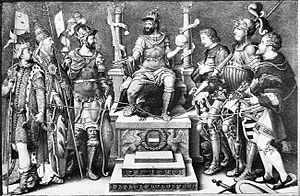
This war was incredibly expensive for both Francis I and Henry VIII. In England, the need for money led to very high taxes and the weakening of the currency. Francis also created new taxes and changed how his government handled money.
Because of the high costs, Francis couldn't help the German Protestants who were fighting Emperor Charles V in the Schmalkaldic War. By the time France could have sent aid, Charles had already won a big victory. For Suleiman, a peace agreement in 1547 temporarily stopped his fight against the Habsburgs.
Henry VIII died on January 28, 1547, and Francis I died on March 31. Henry's successors continued to be involved in Scotland. When fighting started again around Boulogne in 1548, they decided to avoid fighting on two fronts. They returned Boulogne to France four years early, in 1550. Francis was followed by his son, Henry II, whose goals in Italy and dislike of Charles soon led to the Italian War of 1551–1559.
Images for kids
-
Suleiman the Magnificent (painting from the Venetian school, 16th century).
See also
 In Spanish: Guerra italiana de 1542-1546 para niños
In Spanish: Guerra italiana de 1542-1546 para niños


